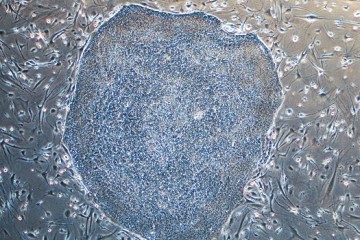A Johns Hopkins University biologist has led a research team reporting progress in understanding the shape-shifting ways of stem cells, which have vast potential for medical research and disease treatment.
In a research paper to be published in Cell Reports on Oct. 13, Xin Chen, an associate professor of biology in the university's Krieger School of Arts and Sciences, and her six co-authors report on how stem cells are affected by their immediate surroundings. The scientists found that an enzyme present in the spot where stem cells are found can help nurture a greater abundance of these cells by sustaining them in their original state, and by promoting other cells to lose their specialized traits and transform into stem cells.
The results show that the enzyme aminopeptidase in the stem cell niche—in this case, the area where stem cells are found in the testicular tissue in fruit flies—plays a role in both of these functions. How the niche itself plays this role, however, remains unclear.
That the enzyme in that spot promotes more specialized cells to become like stem cells "suggests that this change of cell fate needs cues from where stem cells normally reside, but not randomly," said Chen, the principal investigator. "These results have medical implications because if this cell fate change could happen randomly, it may lead to diseases such as cancers."
That's because there's a delicate balance to be struck in managing the proliferation of undifferentiated stem cells in tissue, Chen said. Too few can cause tissue deterioration, too many can promote tumors.
The study focused on fruit flies in part because they share with humans about three-quarters of the genes that cause disease, making them a fine research model. The work on this paper focused on the testis because stem cells are found there in both fruit flies and humans.
Stem cells are found in humans in an array of tissues, including skin, blood vessels, teeth, heart, brain, and liver.
Because they can develop from their original state into specialized or differentiated cells, stem cells have long held out the promise of being used to replace damaged organs and muscle. Stem cells have been used to treat illness in limited ways for decades, including transplantation from bone marrow.
However, their application could be much wider with reliable techniques to control how they take on specialized functions, how they can revert to their stem state, and in some instances, how they proliferate in their original state to form potentially dangerous tumors.
One question now is whether the activity of the niche and of the enzyme reported in this research can be harnessed to manipulate stem cells to differentiate in useful ways. There's a lot of work yet to be done, Chen said.
"How cells become different, it's very important to understand that," Chen said.
Chen's six collaborators on this paper were Cindy Lim, who earned her doctorate at Johns Hopkins and now works for the U.S. Food and Drug Administration; Lijuan Feng of the Johns Hopkins University Department of Biology; Shiv Gandhi and Sinisa Urban of the Howard Hughes Medical Institute, Department of Molecular Biology and Genetics at the Johns Hopkins University School of Medicine; and Martin L. Biniossek and Oliver Schilling of the Institute of Molecular Medicine and Cell Research at the University of Freiburg.
This work has been supported by the 49th Mallinckrodt Scholar Award from the Edward Mallinckrodt, Jr. Foundation, the David and Lucile Packard Foundation, grant RO1HD065816 from the National Institute of Child Health and Human Development, National Institutes of Health, and Johns Hopkins University startup funding for Xin Chen.
Posted in Health, Science+Technology
Tagged stem cells, biomedical research








